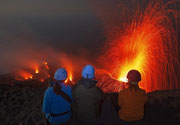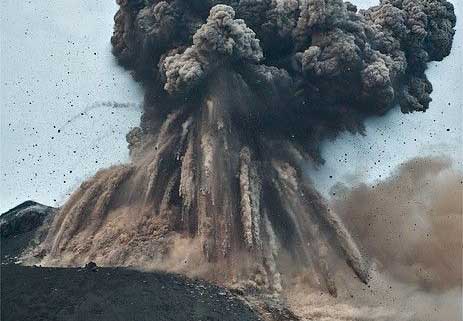Seismic activity and inflation continue at lower levels
Update Fri 08 Apr 2022 06:56
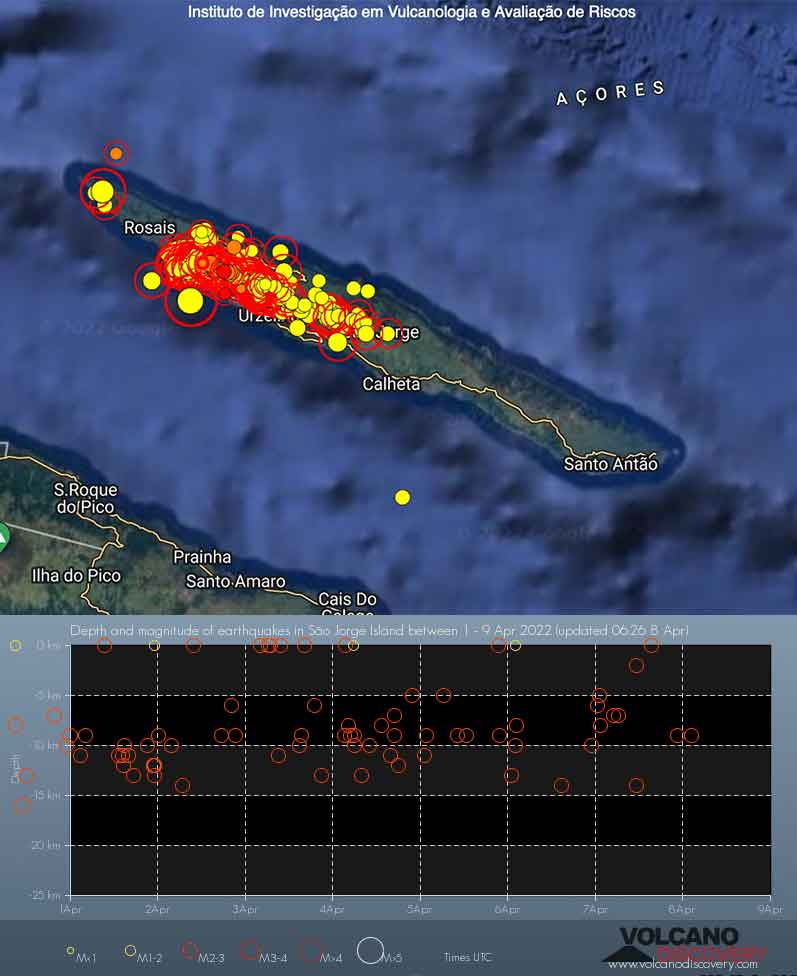
Depth of quakes over time under Sao Jorge volcano
The seismic swarm under the island's northwestern rift zone has decreased a lot during the past days, but it is still ongoing at lower levels.
Weak inflation also continued to be registered, which is why the official alert level remains at the second highest level of V4.
We would like to show you embedded content from X/Twitter. If you like to see this content, please make sure you agree with the
privacy policy of X/Twitter and click the button:
View embedded content from X/TwitterEarthquakes slow down
Update Fri 01 Apr 2022 18:38
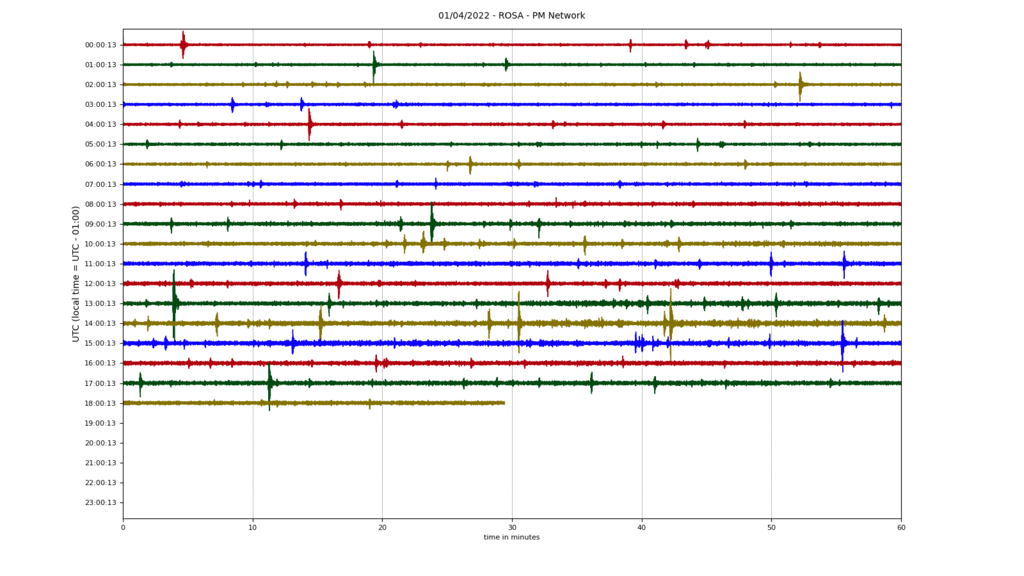
Seismic trace of ROSA station on São Jorge island as of 1 April 2022 evening
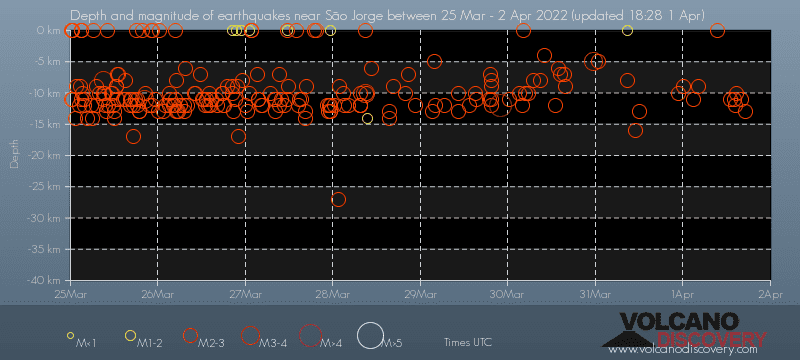
Depth of quakes over time under Sao Jorge volcano
The earthquake swarm continues but with reduced intensity. Only about 10 quakes above magnitude 2.0 occurred in the past 24 hours, although micro-seismic activity remains elevated, and seems to be increasing in the past hours.
Including quakes too small to be localized, official data speak of more than 25,000 tremors in total having occurred since the start of the seismic crisis.
In the absence of other published data, it is impossible to interpret the situation well or make well-founded predictions, but the scenario of a volcanic eruption in a near future seems to become less likely if seismic activity ceases. However, the official alert level remains at V4 (on a scale of 1-6).
Magnitude 4 quake rattles São Jorge island
Update Wed 30 Mar 2022 09:05
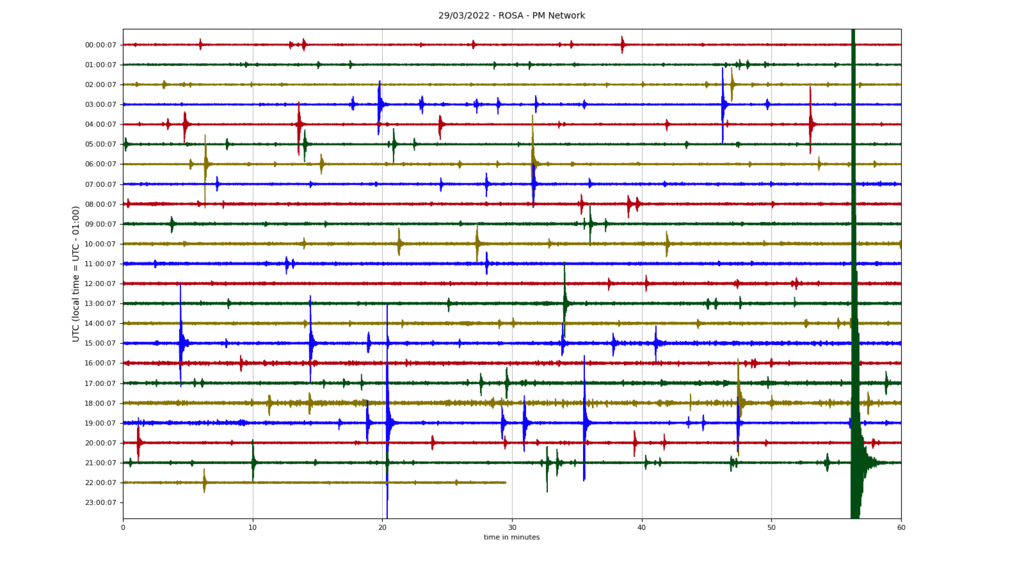
Seismic trace of ROSA station on São Jorge island, showing the magnitude 4 quake in the evening (image:

Accumulated seismic energy during the past 7 days
The seismic swarm continues with the first occurrence of
a widely felt magnitude 4 quake last night at 9:56 pm local time, the strongest so-far in the current swarm. The quake was about 10 times larger than the previous largest-so-far quake, a magnitude 3.3 event at 6.41 pm on 19 March.
While the numbers of quakes has been lower in the past few days, it should be taken into account that last night's quake accounts for approximately the same seismic energy as all quakes during the past 7 days combined. This is because magnitude is a logarithmic scale: one magnitude 4 earthquake is approx. equivalent to 30 quakes of magnitude 3, or 1,000 magnitude 2 events.
Whether this marks a shift in the underlying processes, and whether it is tectonic in origin or caused by magmatic processes or a combination of both, remains unclear.
There were no damages reported by the magnitude 4 earthquake, but authorities and local population remain alarmed because the potential of stronger quakes and/or a volcanic eruption in the near future remains real.
São Jorge Island (Azores): likelihood of eruption increases as 20 million cubic meters of magma estimated intruded at depth
Di, 29. Mär 2022, 07:08 07:08 AM | VON: T
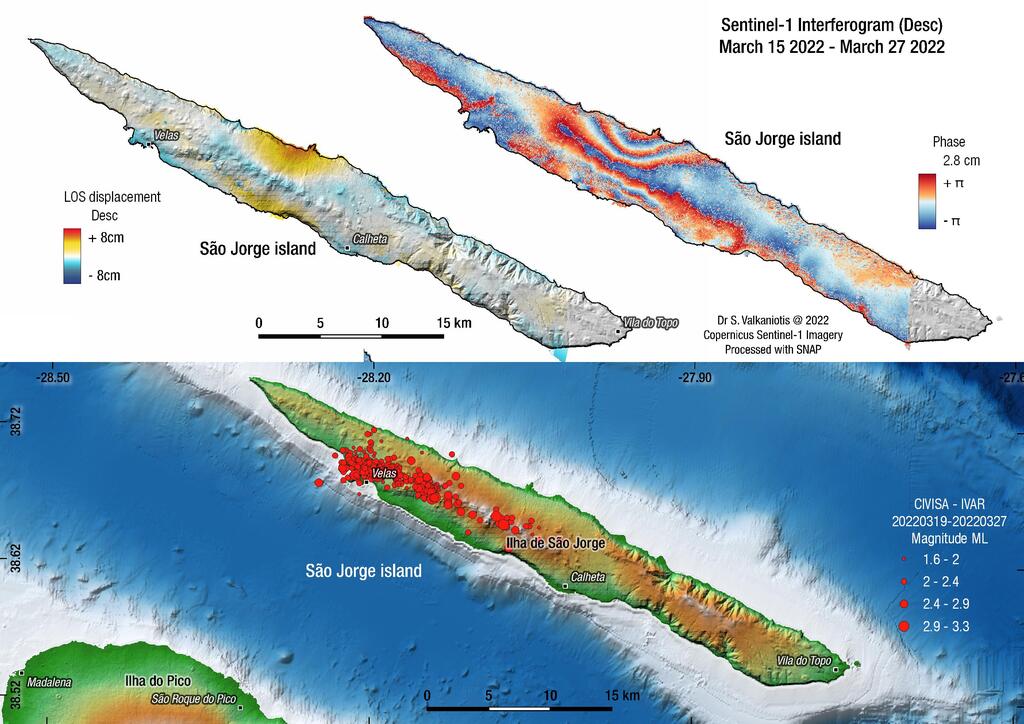
Detected ground deformation at São Jorge island (image: CIVISA)

Depth of quakes over time under São Jorge island
According to latest calculations, the Volcanological Institute of the Canary Islands (INVOLCAN) estimated that as much as 20 million cubic meters of magma have intruded under the island of São Jorge since last March 19.
If the figures are correct, the likelihood of a volcanic eruption in the Azores is no longer a small one, and we therefore assign our color code "orange", as a warning of potential activity in the near future.
For comparison, the initial magma intrusion leading up to last year's eruption on La Palma Island in the Canary Islands was estimated to be only 11 million cubic meters only, while it erupted a total of approx. 300 cu m of magma in the course of the 3-month-long eruption from September-December 2021. The preceding seismic swarm lasted from 13-19 Sep 2021 and is in many ways quite similar to what is being observed now on São Jorge.
The estimates on magma intrusion volume are based on modeling the observed ground deformation, in particular its vertical inflation, from the analysis of synthetic aperture radar data acquired by the Sentinel-1 satellite of the European Space Agency. This method compares radar images of the same area but obtained on two different dates; small differences in phase variations of the reflected radio waves can be used to detect changes in the relief of the earth's surface on the scale of millimeters.
The areas with most uplift is near the northeastern coast approx. 10 km east of Velas, where ground uplift has amounted approx. 10 cm alone by now. It can be presumed that the center of the magma source is located under this area.
The seismic swarm under São Jorge itself so far contained more than 700 quakes of magnitudes above 2.0, with 26 quakes above magnitudes 3.0-3.6. In the past days, it has continued to decrease in intensity, although this does not necessarily mean that the danger is over. Earthquakes occur, when magma pressure opens new pathways, fracturing rock layers at depth. What if the rocks beneath the island are already fractured? This could be true as result of the quakes that already took place, the general setting of the island being in a tectonically active rift zone and the presence of older dikes from past eruptions. In that case, magma accumulation could take place without significant quake activity, and - as we had seen before and during La Cumbre Vieja's eruption on La Palma - an eruption could start any time with little immediate warning.
Possible scenarios for São Jorge volcano:It is impossible to predict what will happen, whether an eruption will take place in the near future. All of the following scenarios are possible, but we do not know how likely each of them might be:
1) An eruption takes place within days or weeks from now, with little warning.
2) The seismic swarm and ground deformation end gradually or abruptly, only to be repeated in months or years from now. Eventually one of these will be leading up to an eruption then.
3) A stronger earthquake occurs and changes the configuration of the magma intrusion, either to stall or to break through to the surface in an eruption.
4) Activity dies down, and the magma intrusion at depth slowly cools over years and decades to come with no further activity directly related to it.
Authorities preparing for emergency
Update Mon 28 Mar 2022 15:29
While hundreds of people have already left the island, especially from Velas, authorities seem to take the situation very serious. Emergency plans are being activated and the army is setting up camps in case people need to evacuate their homes.
We would like to show you embedded content from X/Twitter. If you like to see this content, please make sure you agree with the
privacy policy of X/Twitter and click the button:
View embedded content from X/TwitterUplift detected likely confirming magma intrusion at depth
Update Mon 28 Mar 2022 15:14
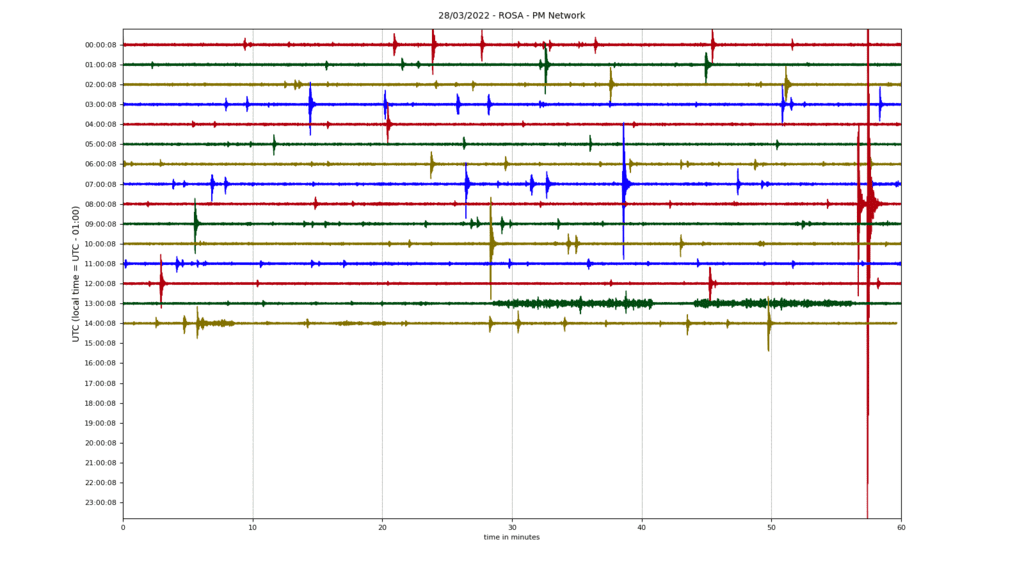
Seismic trace of ROSA station on São Jorge island, showing small quakes and what could be an episode of tremor (image:
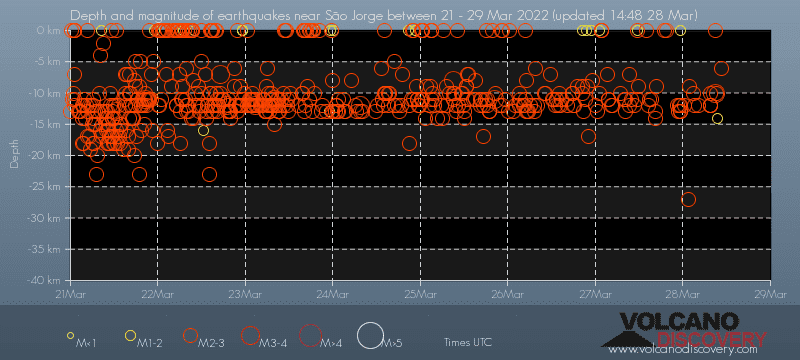
Depth of quakes over time under Sao Jorge volcano
Preliminary satellite-based radar data confirm that a section of island's northern part, roughly corresponding to where the recent quakes have been occurring, has experienced uplift.
This almost certainly confirms that magma intrusion at depth is the cause of the seismic swarm.
We would like to show you embedded content from X/Twitter. If you like to see this content, please make sure you agree with the
privacy policy of X/Twitter and click the button:
View embedded content from X/TwitterThe earthquake swarm itself continues, but has been decreasing in intensity. In the past 24 hours, São Jorge volcano had 1 quake of magnitude 3.0 and 25 quakes between 2.0 and 3.0. On the other hand, the seismic plot has been showing an episode of what
could be volcanic tremor a short time ago this afternoon; it could also be a local disturbance (some machines running near the seismic station etc); we cannot judge this without other data available. However, it if IS volcanic origin, it could be sign that magma has been moving inside some of the newly created conduits.
São Jorge Island (Azores): volcanic-seismic unrest continues at reduced levels
Mo, 28. Mär 2022, 01:52 01:52 AM | VON: MARTIN
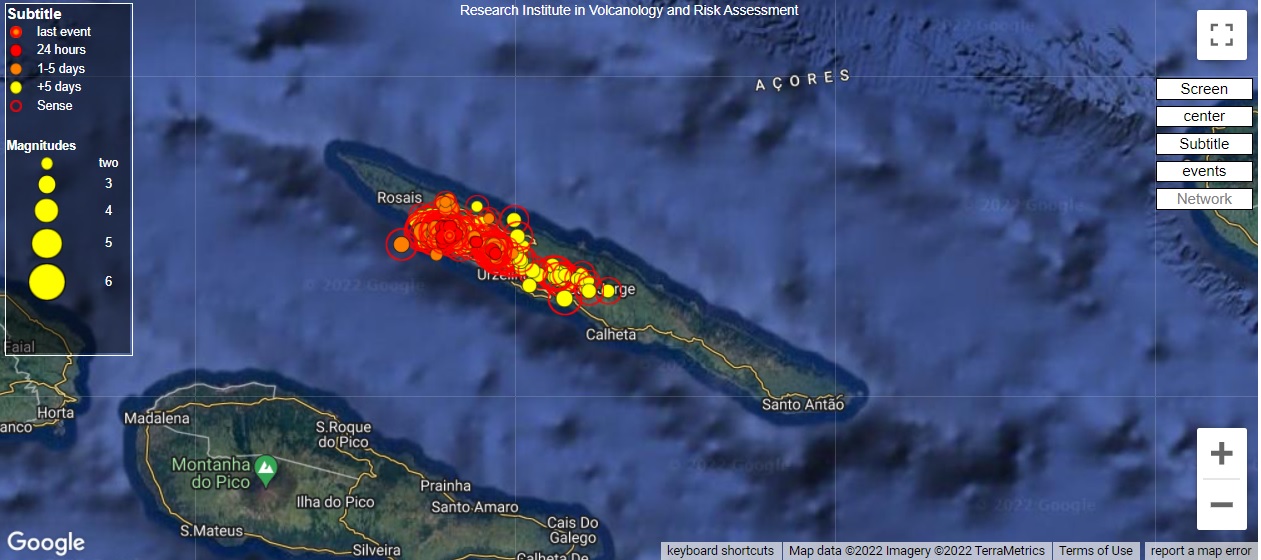
Distribution of earthquakes at São Jorge Island in an NW-SE elongated area (image: CIVISA)
The volcano-seismic crisis on the island continues.
The seismic instruments recorded about 839 earthquakes during midnight and 22:00 local time today even though the seismic activity reduced in the past few days. All detected quakes are characterized by low magnitude levels and tectonic origin so far.
Source: Center For Seismovolcanic Infromation And Surveillance Of The Azores volcano activity update 27 March 2022Evacuations started
Update Sat 26 Mar 2022 08:18
We would like to show you embedded content from X/Twitter. If you like to see this content, please make sure you agree with the
privacy policy of X/Twitter and click the button:
View embedded content from X/TwitterSão Jorge Island (Azores): volcano-seismic crisis continues as scientists conclude magmatic origin, raise alert level
Sa, 26. Mär 2022, 07:47 07:47 AM | VON: T
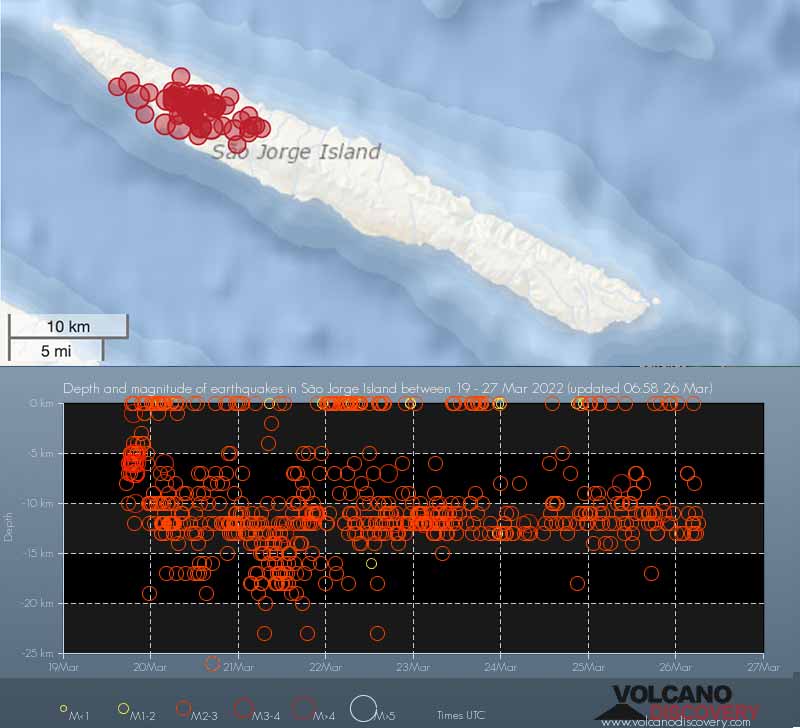
Latest quakes over time under Sao Jorge Island
The volcano-seismic crisis on the island continues. Quakes decreased a bit after the first 48 hours since the swarm started on 19 March, but picked up again lately to almost match the initial intensity.
Over the past 24 hours, São Jorge Island was shaken by 2 quakes of magnitudes 3.0 and 3.2 as well as 57 quakes between 2.0 and 3.0. The location of the quakes remains clustered in an NW-SE elongated area at 10-15 km depth beneath the central-northern ridge of the island, under the sector between Velas and Fajã do Ouvidor.
The Azores Seismovolcanic Information and Surveillance Center (CIVISA) reported that by 24 March, there had been more than 2300 quakes in total, including almost 200 quakes so far felt by the population.
In its latest statement, scientists state that the quakes are "tectonic" in origin, but at the same time also admit that they consider that the quakes could indicate a reactivation of the Manadas Fissural Volcanic System and might very well be a precursor of renewed volcanic activity in the future although it is not believed to be "imminent". In any case, the alert level had been raised to "V4" during the past days.
In the proposed scenario, the current earthquakes are result of deep magmatic intrusions at the mantle-crust boundary below the island into the same areas that fed the historical historical eruptions of 1580 and 1808. A similar seismic crisis was mentioned to have taken place in 1964, presumably in the same area.
All of this confirms the likelihood that magmatic processes are indeed the cause of the current events, and as it's going on, a volcanic eruption might become more and more likely.
Campaigns to measure gases and temperature in the soil have been undertaken since the beginning of this crisis in the epicentral area,
have not shown any anomaly so far, according to CIVISA, but field surveys will continue in the coming days.
Using satellite-based radar ground measurements as well as ground-based monitoring, scientists admit that there is "
some deformation in the epicentral area", another indication that magma has been accumulating at depth.
"The integration of available information allows us to conclude that the
CIVISA warns of the possibility of earthquakes that can reach magnitudes higher than those recorded so far, as well as the danger of landslides potentiated by seismic activity and adverse weather conditions that affect the archipelago.
There is a real possibility that a volcanic eruption could occur, but there is no evidence that this is imminent.", CIVISA concluded.
We would like to show you embedded content from X/Twitter. If you like to see this content, please make sure you agree with the
privacy policy of X/Twitter and click the button:
View embedded content from X/TwitterAs a result, CIVISA has been on ALERT V4 since 3:30 pm on March 20th. CIVISA also issued an alert to the Santa Maria Air Control Center (ACC Santa Maria), the Toulouse Volcanic Ash Advisory Center (VAAC) and the Portuguese Institute of the Sea and Atmosphere (IPMA).
---
Links / Quelle:
São Jorge Island (Azores): seismic swarm continues with no clear trend
Mi, 23. Mär 2022, 19:09 19:09 PM | VON: T
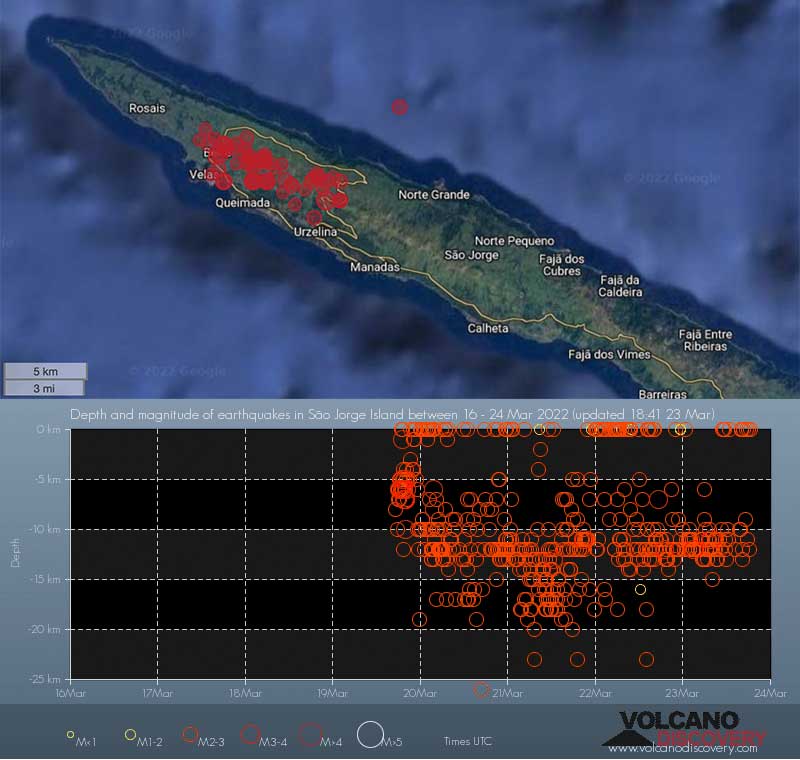
Quakes under Sao Jorge Island in the past 24 hours as well as distribution of depths over time
The seismic swarm under the northern part of the island continues, but at somewhat lower intensity today.
In total, about 100 quakes above magnitude 2.0 occurred in the past 24 hours, the largest a felt
quake of magnitude 3.3 at 6.53 a.m. local time this morning. If to include tiny quakes below magnitude 2.0, the number is approx. 10 times higher.
The locations of the quakes under the island remain concentrated in an elongated area underneath the central northern rift zone in a layer between 10-15 km depth. There is no clear trend in strength and occurrence visible, except that quakes seem to become slightly less frequent over the past 12-24 hours.
While there is no official update from the volcano observatory of the Azores as to any other indications of possible volcanic origin, such as ground deformation, degassing activity etc, it can only be guessed at the moment that these earthquakes could reflect magma intruding into an elongated, approx. 15 km long area at around 10-15 km depth underneath the central ridge of the island, which would corresponds to the lower boundary of the oceanic crust with the uppermost mantle.
If indeed magma intrusion is causing the quakes, the quakes observed are the expression of rock fracturing at depth as magma moves into and forms new sheet-like structures known as dikes.
While volcanic eruptions on ocean islands such as the Azores or the Canaries are almost always preceded by such earthquake swarms, most such earthquake swarms are actually not followed by an eruption as magma often remains stalled at depth; over several years, such swarms then might re-occur as the volcanic system gradually becomes more active, until the intruded magma at depth is "ready" to actually breach the surface and produce an eruption.
Whether the current seismic swarm will end with a new volcanic eruption cannot therefore be said; chances that it will NOT are probably much bigger for the moment than that it will, at least at this point. With the absence of other data, all of this however is to some extent speculation.
São Jorge Island (Azores): seismic swarm could be from magma intrusion, possible precursor of volcanic eruption?
So, 20. Mär 2022, 22:35 22:35 PM | VON: T
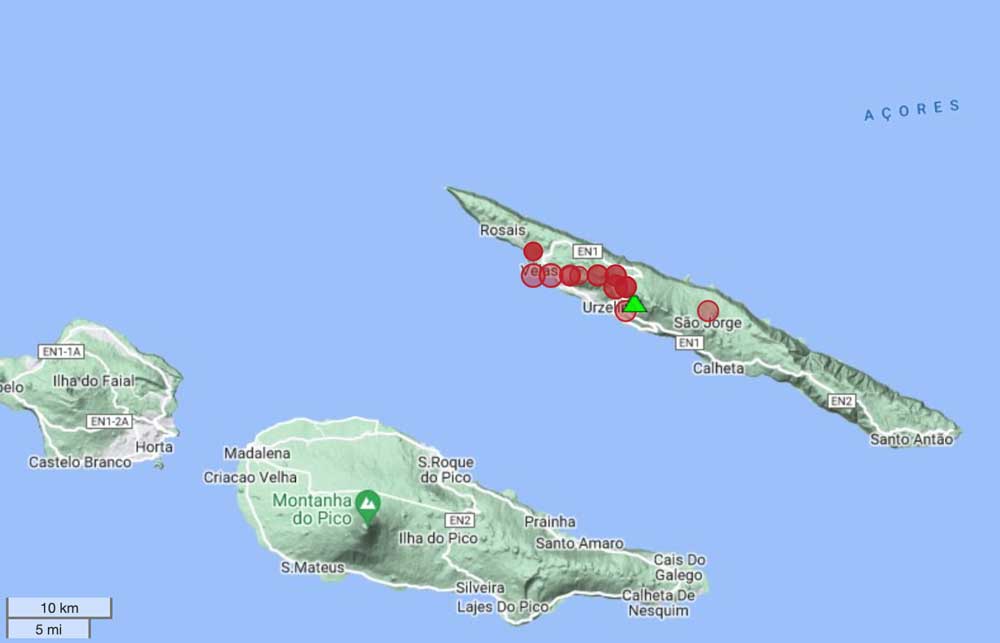
Quakes under Sao Jorge Island in the past 24 hours
A swarm of earthquakes has started yesterday under the northwestern half of São Jorge Island (Azores), with 19 quakes of magnitudes between 2.0-3.5 and many more smaller ones.
Some of the tremors were felt be the population. There is no clear information yet as to the cause of this seismic swarm, in particular whether it is likely caused by a magmatic intrusion at some depth, which could be a precursor or an indication of the re-awakening of the volcano, which last erupted more than 200 years ago in 1808.
To better interpret these quakes, more geophysical data is needed, especially whether there is ground deformation as well, something to expect if magma influx at depth is indeed the cause of the quakes.
The last volcanic activity from São Jorge volcano occurred more than 200 years ago in 1808. The volcanic activity on the narrow, elongated island is mainly related to fissure eruptions from the central rift system.
The current seismic swarm makes many remember the earthquake swarms that preceded the 2021 eruption on La Palma in the neighboring Canary Islands...















